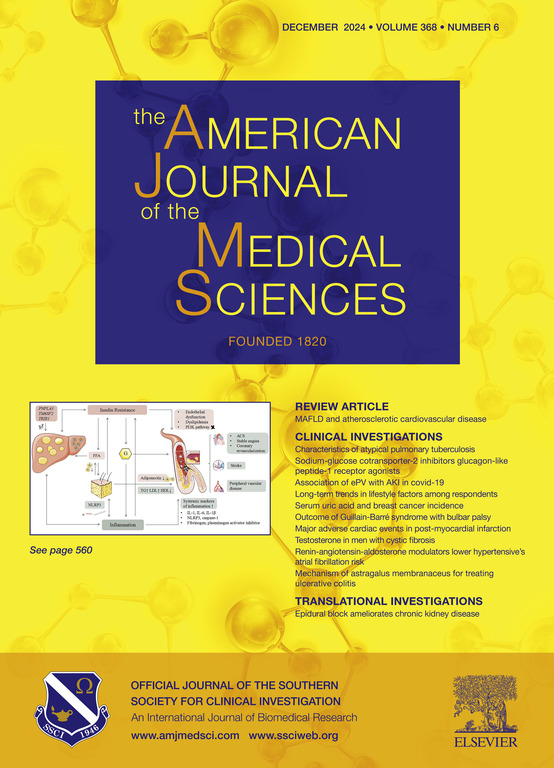在不吸烟、年龄在 30-50 岁、无高血压的普通人群中,全身肥胖和中心肥胖与血铅含量明显相关。
IF 1.8
4区 医学
Q2 MEDICINE, GENERAL & INTERNAL
引用次数: 0
摘要
为了研究普通人群在控制绝经、血压、钙和吸烟后肥胖与血铅水平(BLL)之间的关系,我们评估了2018年KNHANES中无高血压的非吸烟中年受试者的BMI、WC(腰围)和血铅水平之间的关系。所有数据被重新归类为 S1(BMI2 & WC25kg/m2 & WC>90cm)。我们对血铅水平进行了对数变换,使其更接近正态分布。在对社会人口学、能量、工作因素和心脏代谢变量进行调整后,对数变换后的血铅水平与体重指数(P=.010)和体重指数(WC)(P=.020)密切相关。根据血铅含量的季度组别,S3、S2 和 S1 比率的发生率具有可比性。血铅水平可能会增加甘油三酯和低高密度脂蛋白胆固醇的氧化应激;因此,铅暴露可能会形成过氧化亚硝酸盐,这是一种易破坏脂质的活性氧底物(ROS)。因此,在无高血压的非吸烟中年人群中,无论社会人口、能量、工作和心脏代谢因素如何,肥胖都与对数血铅水平显著相关。我们将考虑进一步开展对照临床试验。本文章由计算机程序翻译,如有差异,请以英文原文为准。
General and central obesity were significantly correlated with blood lead level in non-smoking, general population aged 30–50, without hypertension
Introduction
To investigate the association between obesity and blood lead level (BLL) in the general population after controlled for menopause, blood pressure, calcium, and smoking; we assessed the relationship between BMI, WC (Waist Circumference), and blood lead levels in the non-smoking middle-aged subjects without hypertension among 2018 KNHANES. All data were recategorized into S1 (BMI<25 kg/m2 & WC<90 cm), S2 (intermediate), and S3 (BMI>25 kg/m2 & WC>90 cm).
Methods
We made the log transformation of blood lead levels to bring them closer to a normal distribution. Logarithmic transformed BLL was closely related to BMI (p=.010) and WC (p=.020) after adjusting for sociodemographic, energy, working factors, and cardiometabolic variables. The prevalence of ratios of S3, S2, and S1 was comparable according to the quarterly group of BLL.
Results and Conclusions
Blood lead levels might increase oxidative stress on triglycerides and low high-density lipoprotein (HDL)-cholesterol; consequently, lead exposure might form peroxynitrite, a reactive oxygen substrate (ROS) susceptible to destroying lipids. Consequently, obesity was significantly correlated with logarithmic blood lead levels irrespective of sociodemographic, energy, working, and cardiometabolic factors in the non-smoking middle-aged population without hypertension. Further controlled clinical trials would be considered.
求助全文
通过发布文献求助,成功后即可免费获取论文全文。
去求助
来源期刊
CiteScore
4.40
自引率
0.00%
发文量
303
审稿时长
1.5 months
期刊介绍:
The American Journal of The Medical Sciences (AJMS), founded in 1820, is the 2nd oldest medical journal in the United States. The AJMS is the official journal of the Southern Society for Clinical Investigation (SSCI). The SSCI is dedicated to the advancement of medical research and the exchange of knowledge, information and ideas. Its members are committed to mentoring future generations of medical investigators and promoting careers in academic medicine. The AJMS publishes, on a monthly basis, peer-reviewed articles in the field of internal medicine and its subspecialties, which include:
Original clinical and basic science investigations
Review articles
Online Images in the Medical Sciences
Special Features Include:
Patient-Centered Focused Reviews
History of Medicine
The Science of Medical Education.

 求助内容:
求助内容: 应助结果提醒方式:
应助结果提醒方式:


